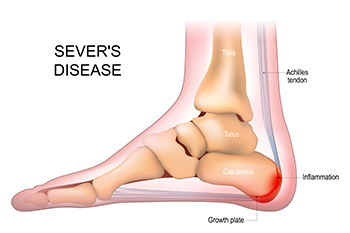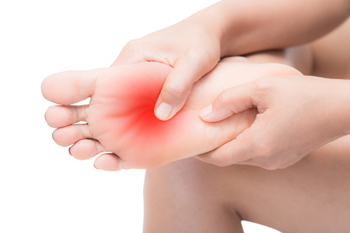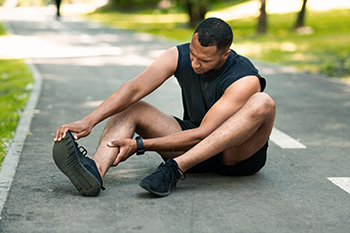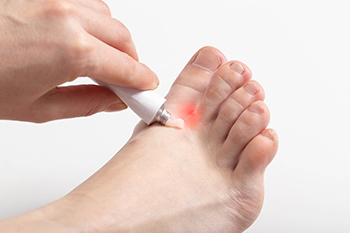Items filtered by date: October 2023
A Common Adolescent Foot Condition

Sever's disease, despite its name, is not a true disease, but rather a common pediatric foot condition. It primarily affects active children and adolescents, typically between the ages of 8 to 14, who are engaged in physical activities or sports. This condition is characterized by pain and discomfort in the heel, particularly the growth plate at the back of the heel bone, where the Achilles tendon attaches. Sever's disease, or calcaneal apophysitis, occurs as a result of the growth plate being pulled on by the Achilles tendon. The growth plate is still developing during adolescence and is vulnerable to injury. Repetitive stress from activities such as running, jumping, or sudden growth spurts can lead to inflammation, causing heel pain. The discomfort tends to worsen with physical activity and can be particularly bothersome during and after exercise. Understanding Sever's disease is vital for parents, coaches, and young athletes. While it is usually a self-limiting condition, meaning it resolves as the growth plate closes, it can be painful and disruptive to a child's daily life. Early recognition and appropriate care are important to ensure a smoother path to recovery for adolescents affected by Sever's disease. If your active child has heel pain, it is suggested that you consult a podiatrist who can accurately diagnose and treat Sever’s disease.
Sever's disease often occurs in children and teens. If your child is experiencing foot or ankle pain, see one of our podiatrists from Pocono Foot & Ankle Consultants. our doctors can treat your child’s foot and ankle needs.
Sever’s Disease
Sever’s disease is also known as calcaneal apophysitis, which is a medical condition that causes heel pain I none or both feet. The disease is known to affect children between the ages of 8 and 14.
Sever’s disease occurs when part of the child’s heel known as the growth plate (calcaneal epiphysis) is attached to the Achilles tendon. This area can suffer injury when the muscles and tendons of the growing foot do not keep pace with bone growth. Therefore, the constant pain which one experiences at the back of the heel will make the child unable to put any weight on the heel. The child is then forced to walk on their toes.
Symptoms
Acute pain – Pain associated with Sever’s disease is usually felt in the heel when the child engages in physical activity such as walking, jumping and or running.
Highly active – Children who are very active are among the most susceptible in experiencing Sever’s disease, because of the stress and tension placed on their feet.
If you have any questions, please feel free to contact our offices located in Stroudsburg, Nazareth, and Easton, PA . We offer the newest diagnostic and treatment technologies for all your foot and ankle injuries.
Definition and Risk Factors for Cracked Heels

Cracked heels, also known as heel fissures, are a common foot condition characterized by dry, thickened skin with visible splits or cracks on the heels. These cracks can be superficial and painless, but in severe cases, they may deepen, bleed, or become painful, making walking and standing uncomfortable. Several factors contribute to the development of cracked heels, and some individuals are more susceptible than others. Dry skin, often due to inadequate moisturization or natural skin type, is a primary cause. The skin on the soles of the feet is naturally thicker and can become dehydrated, leading to cracking. Prolonged standing or walking, especially in ill-fitting shoes, can put excessive pressure on the feet and increase the risk. Additionally, underlying health conditions such as diabetes, thyroid disorders, and psoriasis can make an individual more prone to heel fissures. Effective prevention and treatment for cracked heels include regular moisturizing, wearing comfortable, well-fitting shoes, using foot supports, and addressing any underlying health concerns. If you have cracked heels, it is suggested that you make an appointment with a podiatrist who can prescribe effective medication for relief and recovery.
If the skin on your feet starts to crack, you may want to see a podiatrist to find treatment. If you have any concerns, contact one of our podiatrists from Pocono Foot & Ankle Consultants. our doctors can provide the care you need to keep you pain-free and on your feet.
Cracked Heels
It is important to moisturize your cracked heels in order to prevent pain, bleeding, and infection. The reason cracked heels form is because the skin on the foot is too dry to support the immense pressure placed on them. When the foot expands, the dry skin on the foot begins to split.
Ways to Help Heal Them
- Invest in a good foot cream
- Try Using Petroleum Jelly
- Ease up on Soaps
- Drink Plenty of Water
Ways to Prevent Cracked Heels
- Moisturize After Showering
- Skip a Shower
- Keep Shower Water Lukewarm
- Don’t Scrub Your Feet
If you are unsure how to proceed in treating cracked heels, seek guidance from a podiatrist. Your doctor will help you with any questions or information you may need.
If you have any questions, please feel free to contact our offices located in Stroudsburg, Nazareth, and Easton, PA . We offer the newest diagnostic and treatment technologies for all your foot care needs.
Charcot-Marie Tooth Disease

Charcot-Marie-Tooth disease, or CMT, is a group of genetic disorders that affect the peripheral nerves responsible for transmitting signals between the brain, spinal cord, and the rest of the body. It can also impact the nerves controlling muscle function. Symptoms typically manifest in adolescence or early adulthood, often beginning in the feet and lower legs before spreading to the hands and arms. Common signs include muscle weakness, reduced muscle bulk, diminished reflexes, sensory loss, and foot deformities. CMT is a genetic condition, with various types resulting from mutations in different genes. The two primary categories are CMT1, characterized by issues with the myelin sheath surrounding nerves, and CMT2, involving abnormalities in the nerve axons themselves. CMT3, or Dejerine-Sottas disease, is a severe form that begins in infancy. There is no cure for CMT, but treatment focuses on managing symptoms and maintaining mobility. If you know you have Charcot-Marie Tooth disease or have symptoms characterizing this disease, it is suggested that you make an appointment with a podiatrist for a proper diagnosis and treatment.
Neuropathy
Neuropathy can be a potentially serious condition, especially if it is left undiagnosed. If you have any concerns that you may be experiencing nerve loss in your feet, consult with one of our podiatrists from Pocono Foot & Ankle Consultants. our doctors will assess your condition and provide you with quality foot and ankle treatment for neuropathy.
What Is Neuropathy?
Neuropathy is a condition that leads to damage to the nerves in the body. Peripheral neuropathy, or neuropathy that affects your peripheral nervous system, usually occurs in the feet. Neuropathy can be triggered by a number of different causes. Such causes include diabetes, infections, cancers, disorders, and toxic substances.
Symptoms of Neuropathy Include:
- Numbness
- Sensation loss
- Prickling and tingling sensations
- Throbbing, freezing, burning pains
- Muscle weakness
Those with diabetes are at serious risk due to being unable to feel an ulcer on their feet. Diabetics usually also suffer from poor blood circulation. This can lead to the wound not healing, infections occurring, and the limb may have to be amputated.
Treatment
To treat neuropathy in the foot, podiatrists will first diagnose the cause of the neuropathy. Figuring out the underlying cause of the neuropathy will allow the podiatrist to prescribe the best treatment, whether it be caused by diabetes, toxic substance exposure, infection, etc. If the nerve has not died, then it’s possible that sensation may be able to return to the foot.
Pain medication may be issued for pain. Electrical nerve stimulation can be used to stimulate nerves. If the neuropathy is caused from pressure on the nerves, then surgery may be necessary.
If you have any questions, please feel free to contact our offices located in Stroudsburg, Nazareth, and Easton, PA . We offer the newest diagnostic and treatment technologies for all your foot care needs.
Preventing Falls While Running

Running is a fantastic way to stay active and maintain a healthy lifestyle, but it is not without its risks. One common concern for runners, especially as they age, is the risk of falling. Falls can lead to painful injuries, making it essential to take precautions to stay upright and injury-free during your runs. To start, ensure that your running shoes fit properly and provide adequate support. Pay attention to the running surface by opting for well-maintained trails or sidewalks and being cautious on uneven or slippery terrain. Watch out for obstacles such as rocks, tree roots, or cracks in the pavement. Incorporate core strengthening exercises into your cross training routine to help with balance and stability, and to further reduce the risk of falls. Additionally, when running in low light conditions, wear reflective gear and use a headlamp or flashlight to improve visibility. Lastly, listen to your body to avoid overexertion or fatigue, which can lead to poor form and an increased risk of falling. If you have concerns about your foot health related to running, or need more guidance on fall prevention, it is suggested that you visit a podiatrist.
Preventing falls among the elderly is very important. If you are older and have fallen or fear that you are prone to falling, consult with one of our podiatrists from Pocono Foot & Ankle Consultants. our doctors will assess your condition and provide you with quality advice and care.
Every 11 seconds, an elderly American is being treated in an emergency room for a fall related injury. Falls are the leading cause of head and hip injuries for those 65 and older. Due to decreases in strength, balance, senses, and lack of awareness, elderly persons are very susceptible to falling. Thankfully, there are a number of things older persons can do to prevent falls.
How to Prevent Falls
Some effective methods that older persons can do to prevent falls include:
- Enrolling in strength and balance exercise program to increase balance and strength
- Periodically having your sight and hearing checked
- Discuss any medications you have with a doctor to see if it increases the risk of falling
- Clearing the house of falling hazards and installing devices like grab bars and railings
- Utilizing a walker or cane
- Wearing shoes that provide good support and cushioning
- Talking to family members about falling and increasing awareness
Falling can be a traumatic and embarrassing experience for elderly persons; this can make them less willing to leave the house, and less willing to talk to someone about their fears of falling. Doing such things, however, will increase the likelihood of tripping or losing one’s balance. Knowing the causes of falling and how to prevent them is the best way to mitigate the risk of serious injury.
If you have any questions, please feel free to contact our offices located in Stroudsburg, Nazareth, and Easton, PA . We offer the newest diagnostic and treatment technologies for all your foot care needs.
Common Causes of Athlete’s Foot

Athlete's foot, or tinea pedis, is a prevalent fungal infection that primarily affects the feet. It is essential to understand the causes behind this bothersome condition for effective prevention and treatment. One leading cause is the fungus trichophyton, which thrives in warm, damp environments. Walking barefoot in public areas, such as locker rooms, swimming pools, and communal showers, can expose you to this fungus. Sharing towels, shoes, or socks with an infected person can also facilitate its spread. Sweaty feet create an ideal environment for fungal growth, making individuals with hyperhidrosis more susceptible. Wearing tight, non-breathable shoes can exacerbate the issue, trapping moisture and promoting fungal development. Certain underlying medical conditions, including weakened immunity or diabetes, can also increase the risk of athlete's foot. Preventing athlete's foot involves maintaining good foot hygiene, keeping feet dry, and choosing breathable footwear. If you suspect you have athlete's foot, it is suggested that you consult a podiatrist for a proper diagnosis and tailored treatment options that can effectively manage this condition.
Athlete’s Foot
Athlete’s foot is often an uncomfortable condition to experience. Thankfully, podiatrists specialize in treating athlete’s foot and offer the best treatment options. If you have any questions about athlete’s foot, consult with one of our podiatrists from Pocono Foot & Ankle Consultants. our doctors will assess your condition and provide you with quality treatment.
What Is Athlete’s Foot?
Tinea pedis, more commonly known as athlete’s foot, is a non-serious and common fungal infection of the foot. Athlete’s foot is contagious and can be contracted by touching someone who has it or infected surfaces. The most common places contaminated by it are public showers, locker rooms, and swimming pools. Once contracted, it grows on feet that are left inside moist, dark, and warm shoes and socks.
Prevention
The most effective ways to prevent athlete’s foot include:
- Thoroughly washing and drying feet
- Avoid going barefoot in locker rooms and public showers
- Using shower shoes in public showers
- Wearing socks that allow the feet to breathe
- Changing socks and shoes frequently if you sweat a lot
Symptoms
Athlete’s foot initially occurs as a rash between the toes. However, if left undiagnosed, it can spread to the sides and bottom of the feet, toenails, and if touched by hand, the hands themselves. Symptoms include:
- Redness
- Burning
- Itching
- Scaly and peeling skin
Diagnosis and Treatment
Diagnosis is quick and easy. Skin samples will be taken and either viewed under a microscope or sent to a lab for testing. Sometimes, a podiatrist can diagnose it based on simply looking at it. Once confirmed, treatment options include oral and topical antifungal medications.
If you have any questions, please feel free to contact our offices located in Stroudsburg, Nazareth, and Easton, PA . We offer the newest diagnostic and treatment technologies for all your foot care needs.




